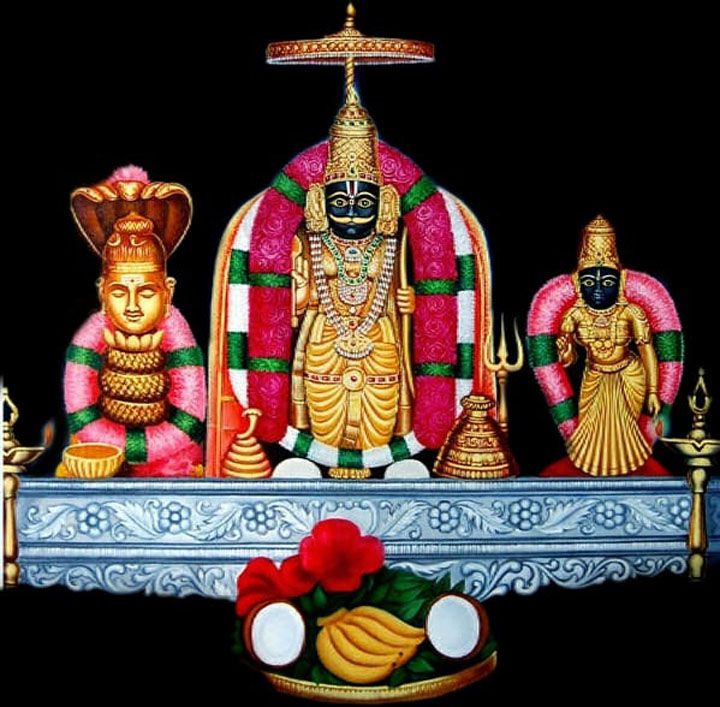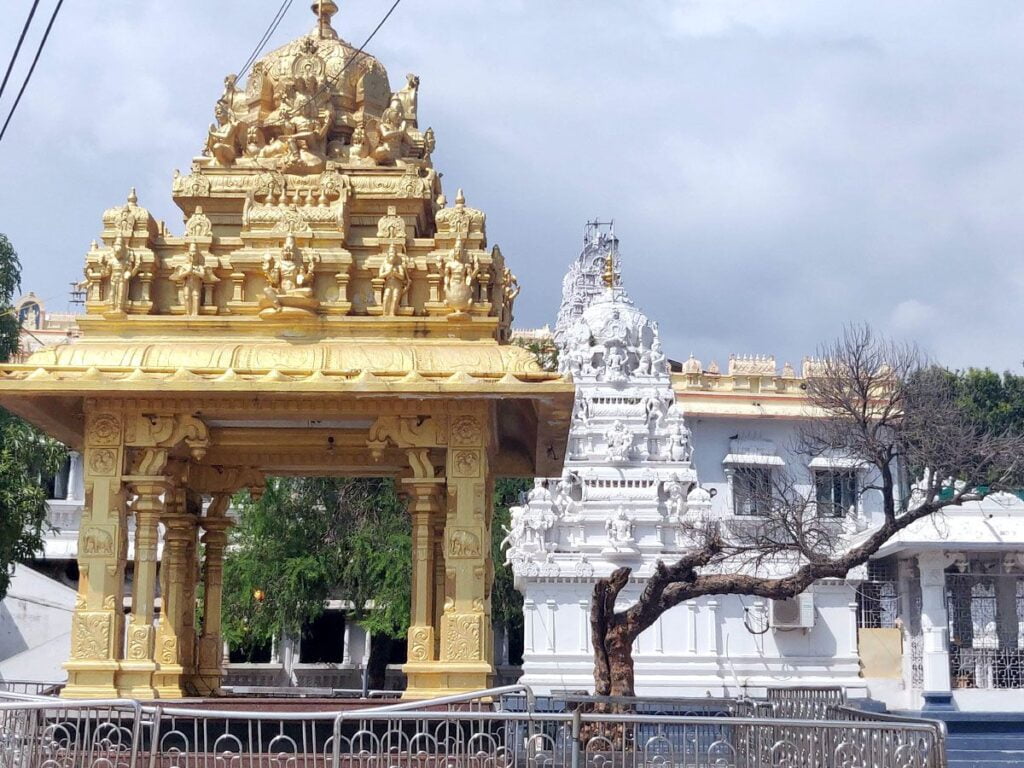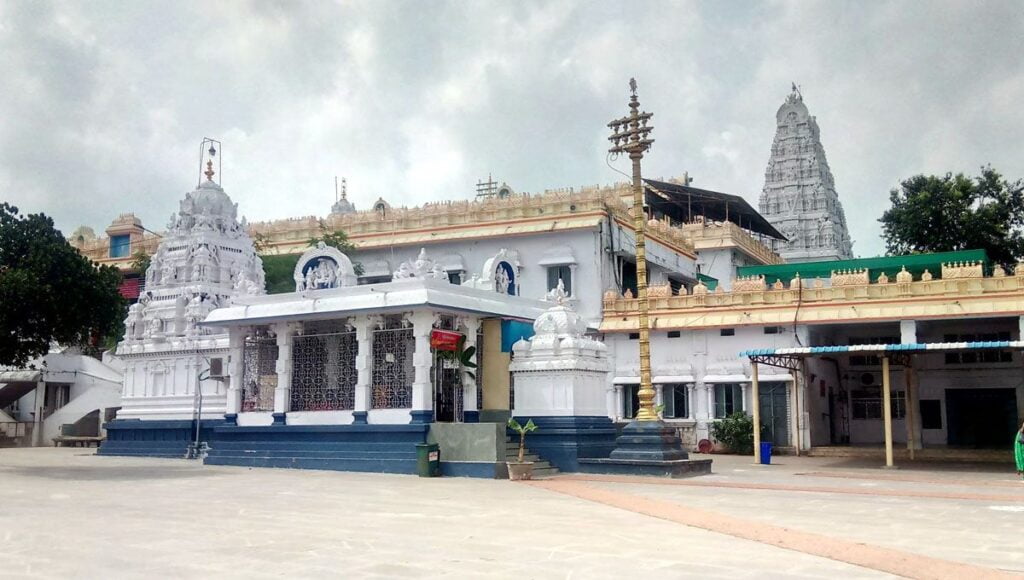Powerful Annavaram Temple Sri Veera Venkata Satyanarayana Swamy
The Sri Veera Venkata Satyanarayana Swamy Temple, popularly known as the Annavaram Temple, is a Hindu temple dedicated to the god Satyanarayana, a form of Vishnu. It is located in the town of Annavaram in the East Godavari district of Andhra Pradesh, India. The temple is one of the most important pilgrimage sites in Andhra Pradesh and is visited by millions of devotees every year.

Contents
- 1 Annavaram Temple History:
- 2 Legend of Annavaram Temple:
- 3 Myths and Beliefs associated with Annavaram Temple:
- 4 Significance of Annavaram Temple:
- 5 Architecture of Annavaram Temple:
- 6 Annavaram Temple Timing and Rituals:
- 7 Places to visit near Annavaram Temple:
- 8 FAQ:
- 9 How to reach Annavaram Temple:
- 10 Google Maps:
The exact history of the temple is unknown, but it is believed to be very old. According to one legend, the temple was built by a local king named Gandhamudi in the 12th century. Another legend states that the temple was built by a sage named Parasara.
The present temple was built in the Dravidian style of architecture in 1891 by Raja Ramanarayana, the then zamindar of Gorsa and Kirlampudi estates. The temple is built in the shape of a chariot, with four wheels at each of the four corners.
The presiding deity of the temple is Lord Veera Venkata Satyanarayana Swamy, a form of Vishnu. The goddess Lakshmi is also worshipped in the temple.
Read More>> 5th CE Yaganti Temple with Mysteries
The legend unfolds with the story of Meru, the king of mountains, and his consort Menaka. Yearning for children, they embarked on a rigorous penance atop Ratnagiri, the hill where the temple now stands. Their devotion pleased Lord Vishnu, who granted them two sons: Bhadra and Ratnakar. Both grew up to be virtuous, but Bhadra’s unwavering dedication to Vishnu eventually led him to become the divine abode of the Lord at Bhadrachalam.
Meanwhile, Ratnakar ascended the throne of Ratnagiri, ruling with wisdom and compassion. However, a devastating famine struck the land, leaving his people starving. Desperate to save them, Ratnakar climbed Ratnagiri once more, this time to plead with Vishnu for his intervention. Vishnu, moved by Ratnakar’s devotion, appeared before him and promised to provide sustenance for his people.
Here, two versions of the legend diverge:
- The Divine Abode: Vishnu declared that Ratnagiri itself would become his permanent abode, taking the form of Veera Venkata Satyanarayana Swamy. This divine presence would ensure no one in the region ever went hungry again. The temple then sprung up on the very spot where Vishnu manifested, its chariot-like structure symbolizing his eternal journey to nourish his devotees.
- The Gift of Annam: In another telling, Vishnu bestowed upon Ratnakar the “Annam Varam,” the boon of abundant food. Ratnagiri became fertile once more, overflowing with grains and fruits. The grateful people named the place “Annavaram” in honor of this divine blessing.
Regardless of the variation, the core message remains the same – the Annavaram Temple stands as a testament to Lord Vishnu’s compassion and his promise to never let his devotees face hunger. This belief continues to draw pilgrims from far and wide, seeking not just physical sustenance but also spiritual nourishment amidst the serenity of the temple and the surrounding hills.
The legend of Annavaram Temple is a beautiful tapestry woven with faith, sacrifice, and divine intervention. It serves as a reminder that even in the face of adversity, hope and sustenance can be found through devotion and unwavering belief.
Read More>> Srikalahasti Temple: 4th Air Vayu Lingam

The legend of Satyabhama Sametha Venkateswara Swamy: According to the legend, Lord Venkateswara was once tricked by his consort Lakshmi into coming down to Earth in the form of a human being. He was then born as Govinda Raju, the son of a king. Govinda Raju grew up to be a strong and handsome man, and he eventually married a woman named Satyabhama. The couple had a happy marriage, but they were childless. Satyabhama prayed to Lord Venkateswara for a child, and her prayers were answered. She gave birth to a son named Rama. However, Rama was soon taken away by a demon named Tarakasura. Govinda Raju and Satyabhama set out to rescue their son, and they eventually defeated Tarakasura and brought Rama back home. After this, Govinda Raju and Satyabhama returned to their heavenly abode.
The belief that Annavaram is the place where Lord Venkateswara’s feet touched the Earth: According to Hindu mythology, Lord Venkateswara resides in Tirumala, but his feet are said to have touched the Earth at Annavaram. This is why Annavaram is considered to be a holy place.
The belief that praying at Annavaram will bring good luck and prosperity: Many Hindus believe that praying at Annavaram will bring good luck and prosperity. This is why the temple is often crowded with devotees, especially during the months of July and August, when the annual Ratha Yatra festival is held.
The belief that the water from the Pushkarini pond in Annavaram has healing powers: The Pushkarini pond is located behind the temple. Hindus believe that the water in the pond has healing powers. They often take a dip in the pond after they have prayed in the temple.
Read More>> Raghavendra Swamy Temple Mantralayam

Religious Importance:
- Powerful Deity: Lord Satyanarayana, depicted as a four-armed figure holding conch, discus, mace, and lotus, is revered for fulfilling wishes and bestowing blessings. Devotees seek his benevolence for prosperity, good health, and marital harmony.
- Auspicious Vratham: The temple is renowned for hosting the “Sri Satyanarayana Vratham,” a special religious vow observed by Hindus across India for blessings in various aspects of life. Newly married couples especially visit the temple to perform this vratham for a happy and successful marriage.
- Divine Unity: Uniquely, the temple enshrines not just Lord Satyanarayana but also Goddess Anantha Lakshmi, his consort, on one side and Lord Shiva on the other. This symbolizes the divine unity and harmony between different aspects of Hinduism.
Historical and Cultural Value:
- Ancient Origins: Though the exact date of construction remains debated, the temple’s history stretches back centuries. Legends link it to the Vijayanagara Empire and freedom fighter Alluri Seetharama Raju, indicating its cultural significance throughout various eras.
- Architectural Splendor: The temple showcases Dravidian architectural style, evident in its gopurams, mandapams, and intricate carvings. The chariot-like design of the main sanctum adds to its visual appeal.
- Tradition and Rituals: The temple pulsates with vibrant traditions and rituals. The daily darshan, prasadam served in traditional dried leaves, and special pujas during festivals like Varamahalakshmi Vratham and Satyanarayana Vratham draw massive crowds.
Beyond Religion:
- Economic Impact: The temple serves as a vital economic hub for the region. Pilgrim influx fuels tourism, generates employment in hotels, shops, and transportation services, and contributes to the local economy’s health.
- Community Building: The temple fosters a sense of community and togetherness. Devotees from diverse backgrounds congregate here, sharing their faith, participating in rituals, and forging bonds over their shared reverence for Lord Satyanarayana.
Read More>> Godavari Tir Shakti Peeth

Dravidian Elements:
- Gopuram: The towering gateway, or gopuram, greets visitors with its colorful gopurams adorned with intricate carvings of mythical creatures and celestial beings. These gopurams, particularly the nine-storied Raja Gopuram, are characteristic of Dravidian temple architecture.
- Vimana: The main sanctum, or vimana, houses the presiding deity and is crowned by a majestic gold-plated kalasam (dome). The vimana’s pyramidal structure with tiered storeys is another prominent feature of Dravidian architecture.
- Mandapam: The spacious halls, or mandapams, within the complex provide areas for religious gatherings and rituals. These mandapams are often intricately carved and supported by ornate pillars.
- Sculptures: The temple walls and pillars are adorned with a profusion of sculptures depicting gods, goddesses, mythical creatures, and scenes from Hindu mythology. These sculptures add a layer of storytelling and religious significance to the temple’s architecture.
Orissan Influences:
- Ratna Shikhar: The distinctive “Ratna Shikhar” adds a unique dimension to the temple’s skyline. This ribbed, barrel-vaulted roof found in Orissan temples adds a touch of elegance and visual interest.
- Jagannatha Motifs: The temple incorporates decorative elements reminiscent of the Jagannatha Temple in Puri, Odisha. These include intricate geometric patterns and floral motifs.
Symbolism and Design:
- Ratnagiri Hill: The temple’s location atop Ratnagiri hill is symbolic, representing Lord Vishnu’s abode, Vaikunta.
- Seven Chariot Wheels: The temple chariot’s seven wheels represent the seven lokas, or cosmic planes, in Hindu cosmology.
- Yantras: The lower level of the temple houses yantras, geometric diagrams with spiritual significance.
Read More>> Tirumala Tirupati Venkateswara Swamy

Timings:
The temple is open for darshan (viewing the deity) from 6:00 AM to 12:30 PM and then again from 1:00 PM to 9:00 PM. There is a brief break from 12:30 PM to 1:00 PM.
Rituals:
- Suprabhatha Seva: The day begins with the Suprabhatha Seva at 4:00 AM, where the deity is awakened with hymns and prayers.
- Dhoopa Seva: This incense offering takes place at 5:00 AM.
- Sarva Darshan: This is the general darshan for all devotees, starting at 6:00 AM.
- Bala Bhogam: This offering of food to the deity occurs at 7:00 AM.
- Abhishekam: This special bathing ritual for the deity takes place from 8:00 AM to 12:00 PM.
- Sri Vari Nitya Kalyanam: This is a daily wedding ceremony for the Lord, conducted at 9:30 AM.
- Rajabhoga Mahanivedana: This offering of food to the deity takes place from 12:30 PM to 1:00 PM.
- Sahasra Deepalankara Seva: This special lighting ceremony with 1000 lamps takes place in the evenings.
For more details about pooja online booking please visit the official website https://annavaramdevasthanam.nic.in/
Read More>> Kanipakam Varasiddhi Vinayaka Swamy
- Pampa Reservoir: Located about 13 kilometers from Annavaram, Pampa Reservoir is a serene water body surrounded by lush greenery. It’s a nice place to relax and enjoy the natural beauty.
- Ryali (Jaganmohini Kesava Swamy Temple): Approximately 24 kilometers away from Annavaram, Ryali is known for the Jaganmohini Kesava Swamy Temple. The unique feature of this temple is the idol of Lord Vishnu, who is portrayed in a combination of human and fish form.
- Draksharamam (Bhimeswara Swamy Temple): About 50 kilometers from Annavaram, Draksharamam is famous for the Bhimeswara Swamy Temple dedicated to Lord Shiva. The temple is one of the Pancharama Kshetras and has significant historical and architectural importance.
- Pithapuram (Kukkuteswara Swamy Temple): Located around 60 kilometers from Annavaram, Pithapuram is known for the Kukkuteswara Swamy Temple, another of the Pancharama Kshetras. The town is also considered one of the Ashta Dasha (18) Shakti Peethas.
- Samarlakota (Bhimeswara Swamy Temple): Approximately 70 kilometers from Annavaram, Samarlakota is famous for the Bhimeswara Swamy Temple. The temple is dedicated to Lord Shiva and is known for its architectural grandeur.
- Kakinada: Situated about 85 kilometers away, Kakinada is a coastal city with beautiful beaches, such as Uppada Beach. You can also explore the Coringa Wildlife Sanctuary, which is known for its mangrove forests and diverse bird species.
- Rajahmundry: Located around 90 kilometers from Annavaram, Rajahmundry is a city on the banks of the Godavari River. You can visit the Dowleshwaram Barrage, the Kotilingala Temple, and take a boat ride on the Godavari.
FAQ:
What is the Annavaram Temple?
The Annavaram Temple is a Hindu temple dedicated to the god Satyanarayana, a form of Vishnu. It is located in the town of Annavaram in the East Godavari district of Andhra Pradesh, India. The temple is one of the most important Satyanarayana temples in the world, and is visited by millions of devotees every year.
What is the history of the Annavaram Temple?
The Annavaram Temple is said to have been built by the Chola king, Kulothunga Chola I, in the 11th century. However, there is also evidence that the temple may have been built earlier, by the Pallava or Pandya kings. The temple has been renovated and expanded several times over the centuries, most recently in the 20th century.
What are the main features of the Annavaram Temple?
The Annavaram Temple is a large and complex complex, with several different shrines and temples. The main shrine is dedicated to Satyanarayana, and is located in the center of the complex. The shrine is surrounded by a number of other shrines, including shrines to Vishnu, Lakshmi, Brahma, Saraswati, and other Hindu deities.
The temple complex also includes a number of other important features, including a pond, a garden, and a library. The pond is said to have been created by the Chola king, and is believed to have healing powers. The garden is home to a variety of plants and flowers, and is a popular spot for pilgrims to relax and meditate. The library houses a collection of Hindu scriptures and other religious texts.
What are the main festivals celebrated at the Annavaram Temple?
The Annavaram Temple celebrates a number of festivals throughout the year. The most important festival is the Satyanarayana Vratham, which is celebrated every year in the month of Ashadha. The festival is a 10-day ritual dedicated to Satyanarayana, and is believed to bring good luck and prosperity to those who observe it.
Other important festivals celebrated at the Annavaram Temple include the Brahmotsavam, which is celebrated every year in the month of Margazhi; the Vasantha Utsavam, which is celebrated every year in the month of Chaitra; and the Deepavali Utsavam, which is celebrated every year in the month of Karthika.
How can I visit the Annavaram Temple?
The Annavaram Temple is located in the town of Annavaram, which is about 100 kilometers from the city of Visakhapatnam. The temple is open to the public every day from 6:00 AM to 9:00 PM.
To reach the Annavaram Temple, you can take a bus or train from Visakhapatnam. The temple is also accessible by road.
What are the dress codes for visiting the Annavaram Temple?
There are no strict dress codes for visiting the Annavaram Temple. However, it is recommended that you dress modestly, especially if you are visiting the main shrine.
Men should wear pants and a shirt, and women should wear a sari or a skirt and blouse. You should also remove your shoes before entering the temple.
What are some tips for visiting the Annavaram Temple?
Here are a few tips for visiting the Annavaram Temple:
- Arrive early, especially if you are visiting during a festival. The temple can get very crowded, especially during peak hours.
- Wear comfortable shoes, as you will be doing a lot of walking.
- Bring a bottle of water, as it can get hot in the temple complex.
- Be respectful of the temple and its traditions.
By Air: The nearest airport to Annavaram is Rajahmundry Airport (approximately 80 km away). From the airport, you can hire a taxi or take a bus to reach Annavaram.
By Train: Annavaram has its own railway station, Annavaram Railway Station, which is well-connected to major cities in Andhra Pradesh and other parts of India. You can check the train schedules and book tickets to Annavaram Railway Station.
By Road: Annavaram is well-connected by road, and there are regular bus services from nearby cities and towns. You can also hire a taxi or drive to Annavaram if you prefer a more private mode of transportation.
From Hyderabad: If you are traveling from Hyderabad, you can take a train or bus to Rajahmundry and then proceed to Annavaram by road.
From Visakhapatnam: If you are traveling from Visakhapatnam, you can take a train or bus to Annavaram directly.
Local Transportation: Once you reach Annavaram, you can easily find local transportation options such as auto-rickshaws and taxis to reach the Annavaram Temple.
